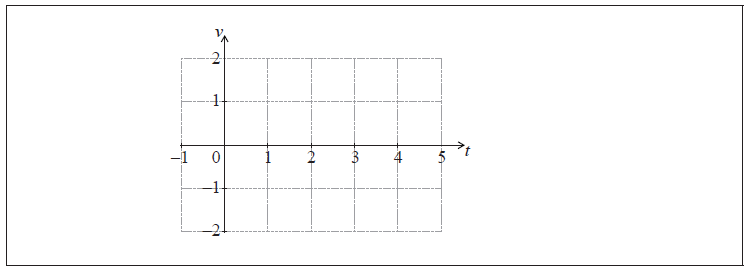| Date | May 2013 | Marks available | 4 | Reference code | 13M.2.sl.TZ1.5 |
| Level | SL only | Paper | 2 | Time zone | TZ1 |
| Command term | Find | Question number | 5 | Adapted from | N/A |
Question
The velocity of a particle in ms−1 is given by \(v = {{\rm{e}}^{\sin t}} - 1\) , for \(0 \le t \le 5\) .
On the grid below, sketch the graph of \(v\) .

Find the total distance travelled by the particle in the first five seconds.
Write down the positive \(t\)-intercept.
Markscheme
A1A1A1 N3
Note: Award A1 for approximately correct shape crossing x-axis with \(3 < x < 3.5\) .
Only if this A1 is awarded, award the following:
A1 for maximum in circle, A1 for endpoints in circle.
[3 marks]
\(t = \pi \) (exact), \(3.14\) A1 N1
[1 mark]
recognizing distance is area under velocity curve (M1)
eg \(s = \int v \) , shading on diagram, attempt to integrate
valid approach to find the total area (M1)
eg \({\text{area A}} + {\text{area B}}\) , \(\int {v{\rm{d}}t - \int {v{\rm{d}}t} } \) , \(\int_0^{3.14} {v{\rm{d}}t + } \int_{3.14}^5 {v{\rm{d}}t} \) , \(\int {\left| v \right|} \)
correct working with integration and limits (accept \({\rm{d}}x\) or missing \({\rm{d}}t\) ) (A1)
eg \(\int_0^{3.14} {v{\rm{d}}t + } \int_5^{3.14} {v{\rm{d}}t} \) , \(3.067 \ldots + 0.878 \ldots \) , \(\int_0^5 {\left| {{{\rm{e}}^{\sin t}} - 1} \right|} \)
distance \( = 3.95\) (m) A1 N3
[4 marks]
Examiners report
There was a minor error on this question, where the units for velocity were given as ms-2 rather than ms-1 . Examiners were instructed to notify the IB assessment centre of any candidates adversely affected, and these were considered at the grade award meeting.
Candidates continue to produce sloppy graphs resulting in loss of marks. Although the shape was often correctly drawn, students were careless when considering the domain and other key features such as the root and the location of the maximum point.
The fact that most candidates with poorly drawn graphs correctly found the root in (b)(i), clearly emphasized the disconnect between geometric and algebraic approaches to problems.
In (b)(ii), most appreciated that the definite integral would give the distance travelled but few could write a valid expression and normally just integrated from \(t = 0\) to \(t = 5\) without considering the part of the graph below the \(t\)-axis. Again, analytic approaches to evaluating their integral predominated over simpler GDC approaches and some candidates had their calculator set in degree mode rather than radian mode.

